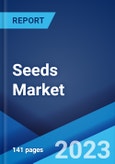Seeds are embryonic plants covered in a protective coating that function as the unit of reproduction for the parent plant. They provide food for a number of animal species, and form a basic part of the agricultural process. Over the past several decades, the significance of seeds in the agriculture industry has increased rapidly on account of advancements in technology and the subsequent introduction of enhanced seed varieties.
One of the major trends which have influenced the seeds market is the significant shift in farming practices worldwide. Nowadays, an increasing number of farmers buy commercially produced enhanced seed varieties as opposed to using seeds from the last harvest. This has been a result of the various advantages offered by enhanced varieties of seeds such as high yield, improved nutritional quality, reduced crop damage, disease resistance, etc. Moreover, the increasing global population and the consequent rise in demand for food, coupled with the expanding biofuel production have also stimulated the demand for enhanced seed varieties worldwide.
Key Market Segmentation:
The publisher provides an analysis of the key trends in each segment of the global seeds market report, along with forecasts at the global, regional and country levels from 2023-2028. The report has categorized the market based on type, seed type, trait, availability and seed treatment.- Conventional
- Genetically Modified Seeds
Breakup by Seed Type:
- Oilseeds
- Soybean
- Sunflower
- Cotton
- Canola/Rapeseed
- Cereals & Grains
- Corn
- Wheat
- Rice
- Sorghum
- Fruits & Vegetables
- Tomatoes
- Melons
- Brassica
- Pepper
- Lettuce
- Onion
- Carrot
- Burpee & Park
- Other Seeds
- Alfalfa
- Clovers and Other Forage
- Flower Seed
- Turf Grasses
Breakup by Trait:
Herbicide-Tolerant (HT)Insecticide-Resistant (IR)
- Other Stacked Traits
Breakup by Availability:
- Commercial Seeds
- Saved Seeds
Breakup by Seed Treatment:
- Treated
- Untreated
Breakup by Region:
- North America
- United States
- Canada
- Europe
- Germany
- France
- United Kingdom
- Italy
- Spain
- Russia
- Others
- Asia Pacific
- China
- Japan
- India
- South Korea
- Australia
- Singapore
- Others
- Latin America
- Brazil
- Mexico
- Argentina
- Others
- Middle East and Africa
- Turkey
- South Africa
- Saudi Arabia
- UAE
- Others
Competitive Landscape:
The competitive landscape of the market has also been analyzed in the report with the detailed profiles of the key players operating in the market. Some of the key players include:
- Bayer Crop Science AG
- Corteva
- Syngenta AG
- BASF
- Limagrain
- KWS SAAT SE
- Sakata Seed Corporation
- AgReliant Genetics, LLC
- DLF Seeds A/S
- Yuan Longping High-tech Agriculture Co., Ltd.
For Each Company, the Report Covers:
- Company Overview
- Key Financials
- Product Portfolio
- Revenue Breakup by Region
Key Questions Answered in This Report
1. What was the size of the global seeds market in 2022?2. What is the expected growth rate of the global seeds market during 2023-2028?
3. What are the key factors driving the global seeds market?
4. What has been the impact of COVID-19 on the global seeds market?
5. What is the breakup of the global seeds market based on the type?
6. What is the breakup of the global seeds market based on the seed type?
7. What is the breakup of the global seeds market based on the traits?
8. What is the breakup of the global seeds market based on the seed treatment?
9. What are the key regions in the global seeds market?
10. Who are the key players/companies in the global seeds market?
Table of Contents
Companies Mentioned
- Bayer Crop Science AG
- Corteva
- Syngenta AG
- BASF
- Limagrain
- KWS SAAT SE
- Sakata Seed Corporation
- AgReliant Genetics LLC
- DLF Seeds A/S
- Yuan Longping High-tech Agriculture Co. Ltd.
Methodology

LOADING...
Table Information
| Report Attribute | Details |
|---|---|
| No. of Pages | 141 |
| Published | September 2023 |
| Forecast Period | 2022 - 2028 |
| Estimated Market Value ( USD | $ 44.4 Billion |
| Forecasted Market Value ( USD | $ 49.6 Billion |
| Compound Annual Growth Rate | 1.9% |
| Regions Covered | Global |
| No. of Companies Mentioned | 10 |









